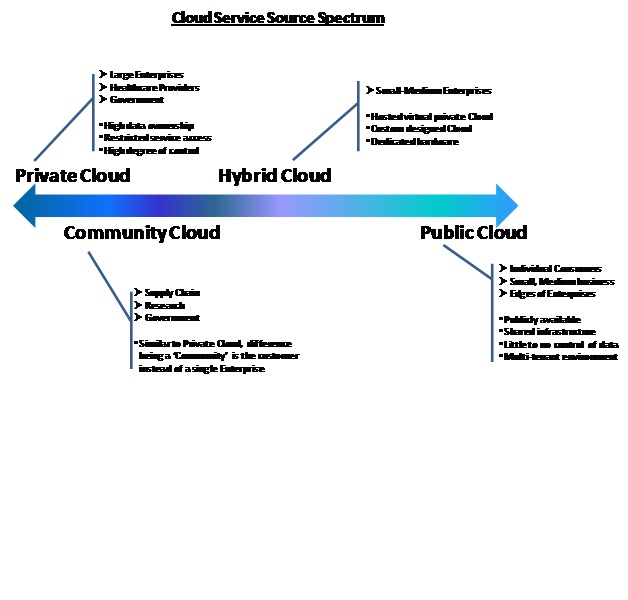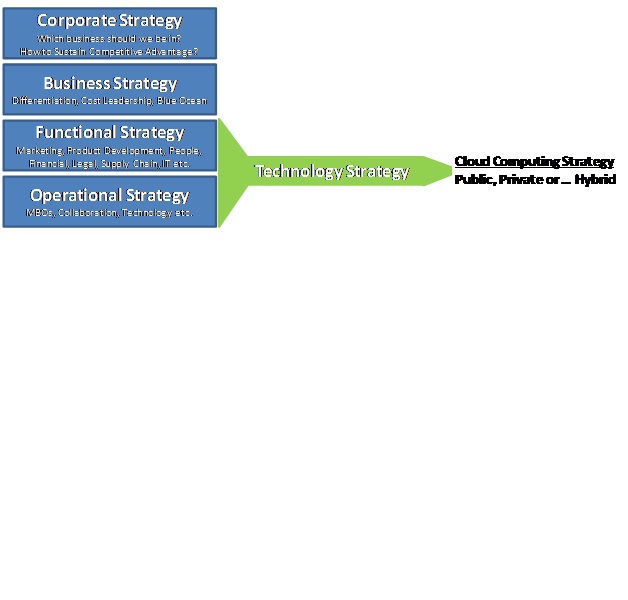Archive for September 2010
When would you choose a Public Cloud over a Private Cloud?
Choosing whether to host a service on a private cloud, or procure it from a public Cloud depends on where the service lies on this spectrum. Services that are critical to differentiating the business will not be easily publically available, moreover, there are likely to be heavy compliance, security and governance restrictions which public Cloud service providers may not currently offer, though over time this may change as demand increases and public Cloud service providers evolve their service standards and agreements. In theory it could be possible to composite services and leverage the diversity of the greater ecosystem to source disparate services in a piecemeal fashion, and aggregating them through a Cloud brokering service who could potentially composite the service tailored to a particular business requirements. However this will require standardization of Cloud interoperability interfaces, metadata and other Cloud related architecture standards and protocols which all are a work in progress to say the least. Given this, such services are potential candidates for private Clouds, however there are still other factors such as economic return, technical and organizational feasibility and other risks and controls that need to be considered.
One could instinctively think that Services which are on the commodity end of the spectrum are strong candidates to be sourced from the public since they are heavily standardized and reusable. This is a fair assumption in many cases; however there will be cases where concerned data and information is business and security critical. In such cases, services would be potential private Cloud candidates.
Aside from analyzing the spectrum of services, network latency may be an issue to consider, depending on the geographic footprint of the organization concerned. Performance is paramount, especially with applications that have to send and receive a great amount of data, and in many cases the latency of the Internet is not acceptable in which case public clouds will not be a viable option.
Some argue that in reality a private Cloud won’t be able to match the elasticity of a public Cloud since it will be restricted to a smaller set of systems, especially given the risk aversion of various business unit and IT managers within the enterprise, as well as the cost benefits varying across the various business uses and IT. In theory this may be true however in practice, we don’t believe this should pose a problem if capacity planning and all other requisite process workflow automation is in place.
One drawback that should be considered is that a private Cloud infrastructure stack needs to be distributed across a heterogeneous environment of many different types of business units and systems, each having their own SLAs. So, as complexity of the environment increases, greater caution (and cost) is needed to manage the private Cloud environment and as more internal customers start to migrate towards the internal Cloud, management of the increasing demands becomes an ever more critical issue.
Where to Begin with your Cloud strategy?
A key differentiator between a public Cloud and private Cloud boils down to a combination of service access, ownership and control. One can imagine a Cloud service source spectrum of Cloud service sources – from pure private Clouds, where services are internally focused on a specific enterprise all the way to pure public Clouds where services are available to all consumers. In between will be examples of shared cloud services for sprawling organizations (such as the federal government), business partners in a supply chain, enterprises in the same corporate park and noncompetitive organizations, such as universities…
There are many moving parts that go into the decision making process of which Cloud service sourcing strategy to pursue. At the most basic level, all decisions, IT and business, need to flow from the corporate strategy downwards to the business strategy level, which in turn feeds into functional and operational strategies.
This is a typical juncture where technology decisions are made in the enterprise. That is not to say that there aren’t extraneous circumstances where the corporate and business’ strategy feeds directly into technology decisions, especially in internet and hi-tech companies such as Google, VMware and Amazon.com, however on aggregate, technology in the traditional enterprise is an enabler of a functional and operational strategy and will be for the foreseeable future. The reference to ‘Technology Strategy’ in Figure 1 implies a broad spectrum of technology and IT decisions, however the focal point of this paper hinges primarily on Cloud Computing Strategy obviously.
Understand the Services is a crucial step towards formulating a Cloud Strategy —
To even being thinking about the Cloud, it is imperative to have access to a Services Portfolio, that is to be able to document and aggregate all services needed to support the functional and operational strategies of the enterprise. Depending on the complexity of your organization, it could be something as simple as an inventory list of services to the more typical and recommended approach of utilizing a portfolio management toolkit.
In many cases, Cloud services either do not exist today, are not proven, do not meet regulatory or legal requirements or simply don’t meet the specific service-level requirements that enterprises desire. Though it is likely that this will remain for some services, we feel that as the industry evolves many of these criteria will being to meet enterprise standards as Cloud computing becomes more and more mainstream.
One of the first steps in formulating a Cloud strategy is to get an idea of which services area candidates for Cloud services, and going a step further, taking an initial educated guess on whether it can be sourced from a private or public Cloud which can be done be understanding the scope and criticality of each service.
It is important to realize that not all services are suitable for Cloud computing. There is a spectrum of services, at one end of the spectrum lies the business critical services – these are measured in terms of functionality, ability to please the customer and differentiate the business. At the other end of the spectrum are the typical standard services, these can be thought of as commodity services such as basic functional offerings related to finance, accounting, IT and so on. These services aren’t highly customized or specific to a business per se.
Bottom Line – there are many moving parts and it is imperative to reconcile business and operations strategy with your technology and Cloud strategy, and to formulate your Cloud strategy be sure you understand the landscape of services your organization provides and consumes!

